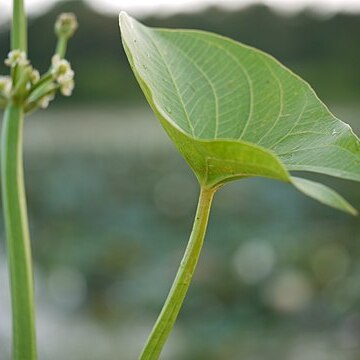Petioles 25–50 cm., triangular in section; leaf-blade obovate in the seedling stage (which sometimes flowers and bears fruit) 3.5 × 1.5 cm.; mature leaves sagittate, 6–9 cm. measured along the midrib, 8–13 cm. wide on a level with the petiole apex; lobes 7–11 cm. long with the angle between them more than 90°; nerves 13–17; blade and petiole glabrous, rarely slightly pubescent or scabrid at the petiole apex.. Peduncle as long as the petioles; inflorescence of 5–7 whorls; bracts glabrous, triangular, 1–2 × 1 cm., with rounded apex; bracteoles 3–6, glabrous, about 3 mm. long; basal whorl with 6–10 hermaphrodite flowers, 0–2 ♂ flowers; pedicels 2–4 cm. long, slender in ♂ flowers, but thickened to 1–2 mm. in diameter and much recurved in fruit.. Sepals about 6 × 3.5 mm. in hermaphrodite flowers, 4 × 2 mm. in ♂ flowers.. Petals delicate.. Stamens 6; filaments 2 mm. long; anthers oblong, 1 mm. long; stamens much smaller in the hermaphrodite flowers.. Carpels 2 mm. long; style 0.5 mm. long.. Achenes ovoid, 4 × 3 mm., shortly stalked, reticulately ridged, rough-textured, pale brown.. Fig. 5/1–5, p. 10.
Apparently annuals, perennating occasionally, up to 1 m high. Roots fibrous, spongy, with transverse septa. Rhizome small. Leaves on long petioles which are triangular in cross-section, spongy, the transverse septa distinct in juveniles; lamina erect, hastate, with the angle between the basal lobes obtuse (more than 90°), the lobes small at first, about as long as the upper part of the blade in mature leaves, apex obtuse, nerves 13-15, the 3-4 lower curving downwards, glabrous or glabrescent, pellucid dotted. Inflorescence a pyramidal panicle up to 1 m high when fully developed, often much reduced in young or small plants; scape stout, woody; flowers in 3-7 dense whorls the lower compound; bracts scarious; lanceolate-acuminate, reflexed with age; fruiting pedicels up to 15 mm long, swollen and woody, sterile pedicels wiry. Achenes about 30, forming a globose head 12 mm in diam., each fruit hard, brown, obpyramidal, 5 mm long, shortly stipitate, ridged.
A herb. It can keep growing from year to year or grow each year from seed. It grows 60-90 cm tall. The leaves are broadly oval and 15-30 cm long. The base is arrowhead shaped. It has spreading triangle shaped lobes. The leaf stalk is 30-80 cm long. The flowering stalks are also 30-80 cm long. There are 5-10 flowers in a ring. They are 1 cm across. They have 3 white petals.
Annual, aquatic herb, up to 1 m high. Leaves with blades erect, hastate, on long petioles which are triangular in cross-section. Inflorescence a pyramidal panicle. Flowers in 3-7 whorls in lower compound. Flowers white.
Inflorescences with spongy peduncles about 2 ft. high
Erect tufted herb with long-stalked leaves
Flowers white


